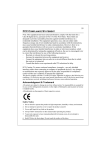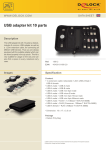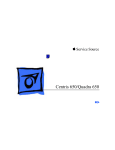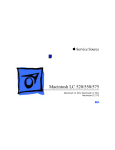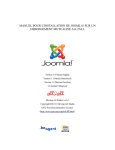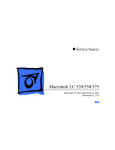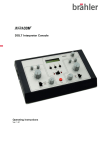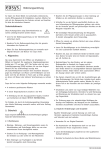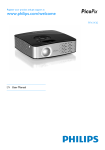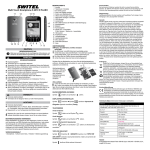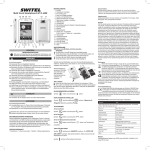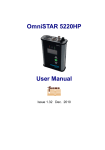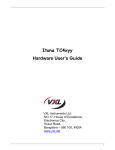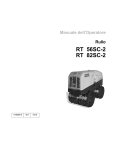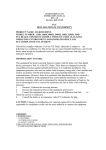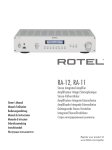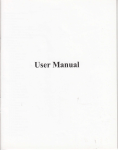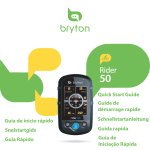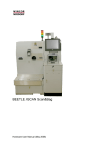Download ATAPI IDE CD-ROM DRIVE
Transcript
20.10.2000 10:05 Uhr Seite 19 ATAPI IDE CD-ROM DRIVE Installation Manual ENGLISH FX2400.2 Atapi CD-ROM FX2400.2 20.10.2000 10:05 Uhr Seite 20 Table of Contents Introduction ...............................................................................21 Product Description ...................................................................22 ENGLISH Safety Information Disk Usage Precautions..........................................................23 Disk Handling Precautions.....................................................23 CD-ROM Drive Parts and Functions Front View ..............................................................................24 Rear View................................................................................25 Installation..................................................................................26 CD-ROM Drive Installation ....................................................27 Integration of the CD-ROM Into Your Operating System......28 Troubleshooting.........................................................................30 Support Hotline .........................................................................31 Glossary.......................................................................................32 Appendix ...................................................................................34 20 ATAPI CD-ROM 20.10.2000 10:05 Uhr Seite 21 Introduction Thank you for purchasing a MITSUMI CD-ROM drive. This installation manual should help you with the installation of your CD-ROM drive. You can find the technical specifications for your drive and the numbers to call up our Support Hotline in the Specifications (Datacard). In the same way as driving a car, the installation of a CD-ROM drive is not a big challenge, but you should know some basic things before you start, just like when driving. We have put together a few questions which you should be able to answer easily if you want to install the drive yourself. • Do you know about problems with electrostatic discharge in connection with computer peripherals? • Do you understand what is meant by a „jumper“? Do you know what a jumper is used for? • Do you know about the different types of ribbon cables used in your PC (36-, 40-, 50-pin)? • Do you know about the terms „Primary“, „Secondary“, „Master“ and „Slave“ in connection with IDE drives? The glossary given in this manual should be able to make clear these points for you. If not, it is best to leave the installation of your CD-ROM drive to an expert. If problems do arise during installation, then please call up our Support Hotline at the numbers given in the list. Help on basic problems, such as the installation of Windows 95, the installation of sound cards from various manufacturers, or any software and hardware from other manufacturers, is not part of the help available from the Mitsumi hotline, since in most cases we do not have the necessary documentation. ATAPI CD-ROM 21 ENGLISH FX2400.2 FX2400.2 20.10.2000 10:05 Uhr Seite 22 Product Description Please contact your dealer if any of these items are missing. Datacard ENGLISH 4 mounting screws (M3, max. 5 mm) 4-pin audio cable • • • • • • • • • Zugriffszeit (1/3 Hub) .................................................... ≥ 120 ms Datenübertragungsrate ............................... 1.800 ~ 2.400 kB/s Cache ................................................................................. 256 kB MTBF ....................................................................... ≥ 50.000 Std. Windows ‘95 kompatibel Treiber für DOS® , WINDOWS 3.1®, Treiber in Windows NT 3.5 enthalten Treiber für OS/2 Warp Horizontaler und vertikaler Einbau möglich • Elektronisches Frontlade-Schubfach • CD-ROM-System ohne Caddy für erhöhte Anwender- • • • • • • • • • Access Time (1/3 stroke) .............................................. ≥ 120 ms Data Transfer Rates .................................. 1,800 ~ 2,400 kB/sec Buffer (cache) ..................................................................... 256 kB MTBF ............................................................................ ≥ 50,000 h Windows ‘95 compatible Driver for DOS®, WINDOWS 3.1®, Driver included with Windows NT 3.5 Driver for OS/2 Warp Mounting horizontal and vertical • Electric Frontload Tray • Caddyless CD-ROM system for increased convenience • Double dustproof system • Headphone connector on front panel with volume control • ATAPI audio connector (Audiocable with Soundblaster • • • • • • • • • Temps d'accès (1/3 de course) ................................... ≥ 120 ms Vitesse de transfert des données ............... 1.800 ~ 2.400 kB/s Cache ................................................................................. 256 kB MTBF ............................................................................ ≥ 50.000 h Compatible Windows ‘95 Pilote pour DOS®, WINDOWS 3.1 ®, Pilote inclus dans Windows NT 3.5 Pilote pour OS/2 Warp Montage: horizontal et vertical • Tiroir en face avant commandé électriquement • Système de CD-ROM sans caddy, plus convivial • Double protection anti-poussière • Prise cascque sur la face avant avec contrôle de volume • Connecteur audio répondant aux spécifications ATAPI et • • • • • • • • • • Tempo di accesso (1/3 di corsa) ................................. ≤ 120 ms Velocità di trasmissione dati ....................... 1.800 ~ 2.400 kB/s Cache ................................................................................. 256 kB MTBF ........................................................................ ≥ 50.000 ore Compatibile con Windows ´95 Eccitatore per DOS®, WINDOWS 3.1.® Eccitatore compreso in Windows NT 3.5. Eccitatore per OS/2 Warp E´possibile un ´installazione orizzontale e verticale Cassetto elettrico a caricamento frontale • Sistema CD-ROM senza caddy per una maggiore semplicità • Tiempo de acceso (1/3 carrera) .................................. ≤ 120 ms • Gado de capacidad de transmisión de datos .............................. 1.800 ~ 2.400 kB/s • Cache ................................................................................. 256 kB • MTBF .................................................................... ≥ 50.000 horas • Compatible con Windows ´95 • Gestor para DOS®, WINDOWS 3.1.® • Gestor contenido en WINDOWS NT 3.5. • Gestor para OS/2 Warp • Instalación horizontal y vertical es posible freundlichkeit • Doppelter Staubschutz • Kopfhöreranschluß mit Lautstärkeregler auf der Frontplatte • ATAPI Audiobuchse (Audiokabel ATAPI auf SoundBlaster Standardstecker ist im Lieferumfang enthalten) • Folgende Standards werden erfüllt: High Sierra, ISO 9660, CD-DA, CD-ROM Mode 1 und 2 (Yellow Book), CD-ROM XA standard connector included) • Compatible with following standards: High Sierra, ISO 9660, CD-DA, CD-ROM Mode 1 and 2 (Yellow Book), CD-ROM XA Form 1 and 2 , CD-i (Green Book), Video CD (White Book), SoundBlaster • Compatibles avec les formats suivants: Form 1 und 2, CD-i (Green Book), Video CD (White Book), Multisession, Orange Book Teil II (nur Lesen), CD Plus, CD Extra • Einfacher Anschluß an bestehendes standard oder enhanced IDE Interface • Secondary IDE Interface MITSUMI „MTM-2183“ (mit AudioAusgang) ist bei Bedarf optional bei Ihrem Händler erhältlich • FCC, UL, CSA, und CE geprüft (BMPT Amtsblattverfügung 243/1991) Multisession, Orange Book Part II (read only), CD Plus, CD Extra • Easy installation using existing standard IDE interface or enhanced IDE interface • Secondary IDE interface MITSUMI „MTM-2183“ (with audio output) optionally available at your dealer if requested • FCC, UL, CSA, and CE approved Vidéo CD (White Book), Multisession, Orange Book partie II (seulement lire), CD Plus, CD Extra • Installation aisée en utilisant votre Carte IDE ou ATAPI • Une carte IDE secondaire „MTM-2183“ (avec Sortie Audio) est disponible optionellement chez votre revendeur • Approuvé par FCC, UL, CSA et CE High Sierra, ISO 9660, CD-DA, CD-ROM Mode 1 et Mode 2 (Yellow Book), CD-ROM Forme XA 1 et 2, CD-i (Green Book), d´uso • Doppia protezione antipolvere • Attacco per cuffia con regolatore di volume sul pannello frontale • Presa audio ATAPI ( è compreso nel volume di fornitura un cavo audio ATAPI su spina standard SoundBlaster) • Vengono rispettati i seguenti standard: High Sierra, ISO 9660, CD-DA, CD-ROM Mode 1 e 2 (Yellow Book), CD-ROM XA Form 1 e 2, CD-i (Green Book), Video CD (White Book), • Bandeja frontal eléctrica • Sistema CD-ROM sin caddy para una mayor facilidad del uso • Protección doble contra el polvo • Conector para auriculares con regulador de volumen en el panel frontal • Conector hembra de audio ATAPI (cable audio ATAPI con conector estándar SoundBlaster contenido en el suministro) • Se cumplen los estándares siguientes: High Sierra, ISO 9660, Multisession, Orange Book Parte II (solo lettura), CD Plus, CD Extra • Attacco semplice all´interfaccia standard esistente oppure all ´interfaccia arricchita IDE • Se necessaria si può acquistare presso il Suo rivenditore un ´interfaccia secondaria IDE MITSUMI „MTM-2183“ (con uscita audio) • FCC, UL, CSA e CE collaudati (BMPT gazzetta ufficiale 243/1991) forma 1 y 2, CD-i (Green Book), Video CD (White Book), Multisession, Orange Book parte II (sólo leer), CD Plus, CD Extra • Conexión sencilla con el interfaz IDE existente, estándar o enhanced • Secondary IDE Interface MITSUMI „MTM-2183“ (con salida audio) disponible bajo demanda en su comercio especializado • Verificado por FCC, UL, CSA y CE (BMPT Boletín Oficial 243/1991) CD-DA, CD-ROM Mode 1 y 2 (Yellow Book), CD-ROM XA Installation manual 3.5 inch device driver diskette ATAPI IDE CD-ROM DRIVE Installations-Handbuch Deutsch English Français Español Italiano Atapi CD-ROM 22 ATAPI CD-ROM 20.10.2000 10:05 Uhr Seite 23 Safety Information Please follow these precautions when handling a CD-ROM or CD: • Do not put any objects on the open tray. • Do not subject the CD-ROM to any strong impacts or vibration. • Only handle CDs by the edge. • Only use special markers to write on CDs and never put labels onto CDs, since these cause vibrations which will affect the running of the CD-ROM. • Always keep compact disks in their sleeves to prevent the delicate surface from being scratched or damaged. • CDs should only be cleaned with a soft, dry cloth by wiping in straight lines from the center outwards. Never use solvents, record cleaner or antistatic fluids of any kind. ATAPI CD-ROM ENGLISH FX2400.2 23 FX2400.2 20.10.2000 10:05 Uhr Seite 24 CD-ROM Drive Parts and Functions 1. Disk Tray 6. Emergency Eject VOL ENGLISH 3. Headphone Jack Fig. 1 4. Volume Control 2. „Busy“ Lamp for Headphones 5. Eject Button Schematic front view (depends on model) 1. Disk Tray Opens or closes for disk loading/removal. Press lightly on the front panel to close. 2. „Busy“ Lamp On during data access or audio playback. 3. Headphone Jack Please note that not all models are equipped with a headphone jack. It is recommended to use low impedance headphones or external loudspeakers with built-in amplifiers. 4. Volume Control To control the volume output for connected headphones. 5. Eject Button Press lightly to open/close the disk tray. 6. Emergency Eject Use only to open the disk tray when the power is switched off. 24 ATAPI CD-ROM 20.10.2000 10:05 Uhr Seite 25 CD-ROM Drive Parts and Functions 10. Device Configuration Block Cable Select Slave Master AUDIO RGGL C.S.M S.L.A IDE INTERFACE 39 40 DC INPUT 1 2 5V G G 12V ENGLISH FX2400.2 9. Analog Line Out 8. Interface 7. Power Supply 11. Digital Line Out Fig. 2 Schematic rear view (depends on model) 7. Power Supply Connection for a standard PC power supply. 8. Interface Port for the 40-pin interface (IDE ribbon cable). 9. Line Out (analog) Analog stereo output for right/left audio channel. 10. Device Configuration Block Setting of these jumpers is explained in the ”Installation” chapter. 11. Digital Line Out Digital stereo output for right/left audio channel. ATAPI CD-ROM 25 FX2400.2 20.10.2000 10:05 Uhr Seite 26 Installation Before an ATAPI CD-ROM can be connected to an IDE or EIDE interface, it must be configured as „Master“ or „Slave“. This is done by setting the jumpers at the back of the unit. ENGLISH Warning: Please turn off all equipment and disconnect the computer power cord from the mains socket before you carry out the installation described below. Setting the configuration jumpers A jumper must be placed in one of the three following positions: SL - Slave This is the default setting. The jumper must be set here if your drive is to be operated as a slave, i.e., if you connect it on the same ribbon cable as an existing hard disk drive. In some cases the jumper setting of the hard disk drive must be modified, too. It must be jumpered as „Master, slave present“. MA - Master This setting is used if the drive is operated as a master device, i.e. stand-alone with its own ribbon cable, or in combination with a second CD-ROM drive, jumpered as „Slave“. CS - Cable Select Use this setting only if you are connecting your CD-ROM drive to an exchangeable hard disk drive and if you have the necessary ribbon cable. The following illustration shows an example in which the jumper is set to „Slave“. MA (Master) SL (Slave) CS (Cable select) 26 ATAPI CD-ROM 20.10.2000 10:05 Uhr Seite 27 CD-ROM Drive Installation 1. Switch off the computer and all interfaced peripherals and disconnect the computer power cord from the mains socket. 2. Remove the computer housing. 3. Install the drive in a vacant 5.25” slot and secure it with the mounting screws supplied. Make sure that the drive is not being stressed or bent by the screws. You can also install your drive vertically. 4. Before connecting the CD-ROM drive to the appropriate IDE interface, you should ground yourself electrostatically by touching the metal housing of your PC. Otherwise high electrostatic charges might destroy the drive and/or electronic components in your PC. 5. The CD-ROM can be connected directly to a sound card, if you have one, with the audio cable supplied. This allows standard audio CDs to be played back. If you have already connected two hard disk drives to your standard IDE controller, an additional IDE controller will be needed for the IDE CD-ROM drive. This secondary IDE controller, part no. MTM2183, can be obtained at your Mitsumi dealer. You should, however, check first whether your computer does not already have an Enhanced IDE controller with a secondary IDE interface. ATAPI CD-ROM 27 ENGLISH FX2400.2 FX2400.2 20.10.2000 10:05 Uhr Seite 28 Integration of the CD-ROM Into Your Operating System The procedure for installing the device drivers and integrating the CD-ROM into the computer operating system differs from case to case. The list below is by no means complete and can only describe the basic steps of installation. ENGLISH One important point is the fact that, depending on the driver or operating system used, your drive may be recognized only as Mitsumi ATAPI drive or an older Mitsumi CD-ROM drive model. Due to the hardware-independent ATAPI standard, however, this will not affect the speed of your drive. Please refer to the user manual on your operating system for further installation instructions. DOS/Windows 3.x A separate driver installation is required for the MS-DOS operating system (Novell DOS, PC DOS, etc.). You will require the supplied driver diskette and the information on where the file „MSCDEX.EXE“ is located (this only applies for MS-DOS, the name may differ in DOS versions from other suppliers). Please consult your manual for further information. Insert the supplied device driver disk into your floppy disk drive and start the installation program by typing <drive>:\SETUPD where <drive> is the letter used to identify your disk drive (e.g. A:\SETUPD). The menu-driven installation program will now guide you step by step through the installation routine and update the files CONFIG.SYS and AUTOEXEC.BAT. If so desired, it will also update the SYSTEM.INI file in Microsoft Windows version 3.x. SETUP assumes a standard configuration using the primary or secondary IDE interface. If this is not the case, you need to change the corresponding entry in CONFIG.SYS (see Appendix 1). Windows 95, Windows NT, OS/2, Linux Support of ATAPI CD-ROM drives has already been implemented in these operating systems and no additional drivers are required. The following gives you specific information on the individual operating systems. 28 ATAPI CD-ROM 20.10.2000 10:05 Uhr Seite 29 Integration of the CD-ROM Into Your Operating System Windows 95 During the starting process, Windows 95 checks your computer hardware configuration in order to identify new internal or peripheral devices. In some rare cases, Windows 95 will not be able to clearly identify the installed hardware. In such cases please check the hardware installation of the CD-ROM: the connection to the IDE interface, if the IDE interface has been activated or the interface cable correctly connected, and check for correct jumpering. Windows NT There are differences between installation under Windows NT 3.5x and Windows NT 4.0. In Windows NT 3.5x the required configuration utility „Win-NT-Setup“ is in the ”Main” group. Start this utility and go to the Options menu item „Add/Remove SCSI adapters“, select the driver „IDE CD-ROM (ATAPI)“, confirm the selection, and reboot your computer. The corresponding configuration utility is located in System Control under Windows NT 4.0. Otherwise the driver installation is the same as under Windows NT 3.5x. Linux Support of your CD-ROM drive is included in the operating system. OS/2 Warp OS/2 Warp automatically identifies your CD-ROM drive. For an installation under OS/2 2.21, you require the drivers located on the disk in subdirectory OS/2. Further information is contained in the ReadMe files on the diskette. ATAPI CD-ROM 29 ENGLISH FX2400.2 FX2400.2 20.10.2000 10:05 Uhr Seite 30 Troubleshooting ENGLISH Your CD-ROM is designed for a long and trouble-free service life. If problems do occur, please check first whether the drive installation has been carried out as described, and whether the appropriate drivers and programs have been installed correctly and are working properly. If that is not the case, please refer to the following list of commonly occurring malfunctions. If this still does not produce the desired solution, do not hesitate to contact our Support Hotline (the telephone and fax numbers are given in the attached sheet). Problem: The disk tray does not open. Please check whether the power supply and ribbon cables have been connected correctly, or whether the CD-ROM has been connected to an old control card or to an interface on a sound card which do not in fact have an IDE interface. Problem: The drive has been installed on the same ribbon cable as an existing hard disk drive. When the computer is switched on, the hard disk can no longer be found. In this configuration the jumper must be set so that the hard disk is master and CD-ROM drive is slave. If this has already been done, the jumper settings on the hard disk must be changed from „Master, no slave“ for example, to „Master, slave present“. Please consult the instruction manual for your hard disk drive for further information on the correct jumper setting. Problem: The drive is working but there is no sound from the sound card. Is the audio cable correctly connected to the CD-ROM drive and the sound card? Have the loudspeakers been connected properly? Your CD-ROM drive has an audio connector with the following pin assignments: Pin 1: Right audio channel Pin 2: Ground Pin 3: Left audio channel Pin 4: Not used The pin assignments may not correspond to those of your sound card. Please consult the manual for your sound card to check this. Problem: The drive does not function, although it has been correctly connected to a primary or secondary port using the default values. Please check if this involves an older cache controller (with or without its own BIOS). Unfortunately these are often not 100%-compatible with the ATAPI standard, even though this involves an EIDE controller. In such cases you should deactivate the secondary port on the cache controller card and install an additional secondary port to connect the CD-ROM. 30 ATAPI CD-ROM 20.10.2000 10:05 Uhr Seite 31 Support Hotline In addition to good product quality, MITSUMI also takes pride in providing excellent customer support. For this reason we are running the MITSUMI Electronics European Support Hotline to assist our customers with installation problems or questions at any time. However, the Support Hotline personnel depend on you, the callers, providing comprehensive information to allow us to give instant solutions to problems. ENGLISH FX2400.2 Which CD-ROM drive model are you using? Which device driver version are you using? Exactly what kind of PC are you using? Which main board and which IDE controller are installed? How is your CD-ROM drive connected? Which port is it connected to (primary or secondary, master or slave)? Which operating system are you using? Which version? What information is in your start-up files (CONFIG.SYS, AUTOEXEC.BAT and Windows SYSTEM.INI)? It will help to print these files out beforehand. More information on our Support Hotline is given in the attached sheet. Moreover, we offer technical support and more information on the Internet under http://www.mitsumi.de. There you will find answers to the most frequently asked questions, and you can also download the most up to date drivers. ATAPI CD-ROM 31 FX2400.2 20.10.2000 10:05 Uhr Seite 32 Glossary ATAPI stands for Advanced Technology Attachment Interface. An ATAPI device is interfaced to an IDE controller using a 40-pin ribbon cable. See also EIDE. ENGLISH IDE/EIDE stands for Integrated Drive Electronics and Enhanced Integrated Drive Electronics respectively and describes the hardware interface to connect (E)IDE hard disks and ATAPI-compatible devices (CD-ROM, see also ATAPI). IDE can only make use of one IDE port, the so-called primary port, which can operate a maximum of two (E)IDE or ATAPI devices in a master/slave combination. EIDE can make use of a second IDE port, the secondary port, which can likewise operate two devices. This means that an EIDE system can operate up to four (E)IDE devices. EIDE Port 1 primary Port 2 secondary Device 1 Device 2 Master / Master, Slave present Slave Device 1 Device 2 Master / Master, Slave present Slave CD-ROM is the description for Read Only Memory data CDs. The original standard was specified in the so-called „Yellow Book“ and was extended subsequently. The standard is divided into CD-ROM mode 1 and CD-ROM mode 2. Further information on the structure can be found in the corresponding standard sources. CD-ROM/XA stands for Extended Architecture. This format is compatible with CD-ROM mode 1, and mode 2 and also permits nesting of data, audio sequences and video images. CLV stands for Constantly Linear Velocity. The data tracks of a CD must be read at a constant speed. In order to achieve this, the speed of the CD-ROM drive must be constantly adjusted as there are more data blocks on the outer tracks than on the inner tracks. 32 ATAPI CD-ROM 20.10.2000 10:05 Uhr Seite 33 Glossary CAV stands for Constant Angular Velocity. The data tracks of a CD are read at a constant speed, which greatly increases the data transfer rate. MIXED MODE CD is a CD with one data track and appended audio tracks. MPC is a definition for the hardware requirements for a multi-media PC. At present MPC-I, MPC-II and MPC-III have been defined. MPEG is a high-performance compression routine for digitized films. Due to the high compression ratio, the data can only be decompressed and displayed using special add-on boards or programs. MSCDEX stands for Microsoft CD-ROM Extensions. This extends the file system of a PC to allow it to incorporate CD-ROM drives. MULTISESSION CD is a CD which has been written to in the course of several write sessions. PHOTO-CD is a process developed by Kodak to allow photographs to be recorded on CDs. PHOTO-CD basically corresponds to the CD-ROM/XA standard, but has been expanded by the facility to write images onto the CD in several subsequent sessions (see Multisession). QUICKTIME was developed by Apple. Together with Video for Windows by Microsoft, it is the main format for the compression and playback of video data by means of a software program. The file extension is normally *.MOV. The so-called RAINBOW BOOKS define the various file and recording formats used for CD-ROMs. They are currently divided into the following formats: Red Book (Digital Audio), Yellow Book (CD-ROM), Green Book (CD-I), Orange Book (CD-WO and CD-MO), White Book (Video CD) and Blue Book (CD Plus). VIDEO FOR WINDOWS was developed by Microsoft. Together with Quicktime by Apple, it is the main format for the compression and playback of video data by means of a software program. The file extension is usually *.AVI. ATAPI CD-ROM 33 ENGLISH FX2400.2 FX2400.2 20.10.2000 10:05 Uhr Seite 34 Appendix 1 MTMCDAI.SYS Device Driver Parameters in CONFIG.SYS ENGLISH The MTMCDAI.SYS driver is a software interface between the CD-ROM drive and MSCDEX.EXE and is included in CONFIG.SYS. Setup is done for a standard configuration for the primary or secondary port with the default values for port address and interrupt. If your hardware installation differs from this, the corresponding entry must be made in CONFIG.SYS. The line has the following syntax: DEVICE=[DRIVE:][path]MTMCDAL.SYS /D:device name [/P:xxx,yy] [/A:n] [/U:n] [/L:xx] Note: The actual entry must be written in its full length in a single line within the CONFIG.SYS file. DEVICE= / DEVICEHIGH= These commands are used within CONFIG.SYS to install device drivers into memory when the PC is booted. „ DEVICE =“ installs the driver into conventional memory and „ DEVICEHIGH=“ loads the driver into high memory. [Drive:][Path]MTMCDAI.SYS Defines the location (drive and directory) and the name of the device driver. /D:<Device name> This parameter allows you to use any desired device description (max. 8 characters) for your CD-ROM and must be identical with the corresponding parameters used in MSCDEX.EXE (see MSCDEX) in AUTOEXEC.BAT. [/P:xxx,44yy] Defines the port address for the drive (i.e. the memory address for the IDE port) and the IRQ (interrupt request). „xxx“ indicates the port address of the IDE port. xxx = 34 1f0 170 1e8 168 primary port address (channel 1) secondary port address (channel 2) channel 3 channel 4 ATAPI CD-ROM 20.10.2000 10:05 Uhr Seite 35 Appendix 1 „yy“ indicates the interrupt request (depending on the controller): yy = 14 15,12,11,10 12 or 11 10 or 9 primary port (channel 1) secondary port (channel 2) channel 3 channel 4 [/A:n] Defines the audio playback mode. Settings /A:0 or /A:1 can be selected for stereo CDs. For mono CD playback (left-hand or right-hand channel only) the /A:1 setting plays the mono audio signal via both the right-hand and left-hand channels. The standard (default) setting for normal playback is /A:0. [/U:n Defines the locking or opening of the tray to prevent unauthorized access after booting. /U:0 means „Unlock“ (the default setting) and /U:1 means „Lock“. [/L:xx Defines the language for output messages. The language can be selected according to the following codes: ”xx” = US English (default setting) FR French IT Italian GR German SP Spanish JP Japanese Installation of Device Driver MTMCDAI.386 Device driver MTMCDAI.386 is only required if your Windows version 3.1x runs with 32 bit hard disk access activated and if your CD-ROM is connected to the same IDE port as your hard disk. This file is automatically installed with the installation program SETUPD. If manual installation is necessary, simply add the following line to the [386enh] section of Windows SYSTEM.INI: DEVICE=[Drive:][Path]MTMCDAI.386 ATAPI CD-ROM 35 ENGLISH FX2400.2 FX2400.2 20.10.2000 10:05 Uhr Seite 36 Appendix MSCDEX.EXE Parameters in AUTOEXEC.BAT ENGLISH MSCDEX.EXE forms part of Microsoft DOS v6.00 and higher and Microsoft Windows 3.00 and higher. This program is required to incorporate the CDROM drive via an additional drive designation letter into the file system of your computer. Users of other DOS versions, such as Novell DOS, should refer to their DOS manual to find out what their equivalent of MSCDEX.EXE is called and which parameters it supports. Please note that MSCDEX.EXE can only be used with DOS version v3.00 and higher. /D:<device name> This parameter tells MSCDEX.EXE the name of the device driver. It must correspond to the name used during loading of the device-specific driver in CONFIG.SYS. /E MSCDEX.EXE is to use expanded memory. /L:<letter> Indicates the drive letter to be used for the CD-ROM drive. Without this parameter, the next available drive letter will be used. /M:<size> Indicates the size of the memory buffer to be used. A value of 10 corresponds to 20 kB of memory. Values above 32 have no significant effect on the performance of the drive. /V Provides verbose information on the use of memory. /S Allows the CD-ROM drive to be shared in a local network. Microsoft is a registered trademark of Microsoft Corporation. MS-DOS is a registered trademark of Microsoft Corporation. Windows is a registered trademark of Microsoft Corporation. IBM is a registered trademark of International Business Machines Corporation. 36 ATAPI CD-ROM


















